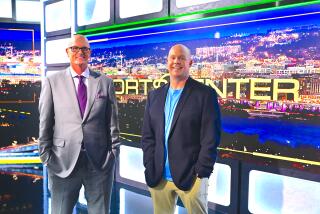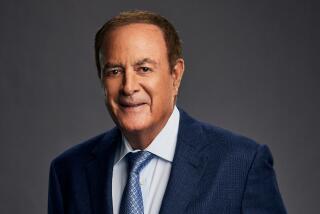And the Winner Is . . . but First, We Go to Commercial
- Share via
Perhaps you were paying attention a couple of weeks ago at the Kentucky Derby when the great god Television was up to its old tricks. Getting the greatest good, ensuring undivided attention to its commercials.
The scenario was this: They had just run perhaps the closest race in the history of the Kentucky Derby--at least since 1933--and it was impossible to separate the winner from the place horse. It looked as if we might get the first dead heat in the 122 runnings of the venerable race.
Now, what you do in cases like this, if you’re at the track, is scan the riders for telltale signs they thought they won; you look for exultant grooms, some sign as to how the finish will go. Sometimes, a bettor has even been known to sell his ticket on the chance he lost anyway.
It’s a highly dramatic moment, great theater, 100,000 people about to let out a roar when the photo is developed and posted. You want to be right there when the winner’s number goes up.
If you were watching Channel 7 that day, you didn’t get that privilege. You were watching, instead, about five loud, beside-the-point commercials for various products. You got those instead of the drama playing out at the track.
By the time they returned to the live action, the winner was history. The number had been put up, the crowd reaction was over. What you got was anticlimax. Yesterday’s roses.
Now, I submit this is not exactly coincidence. I mean, if you have a commercial to project, what better time than when millions of race fans, or just viewers generally, are glued to the tube, anxiously scanning the screen to find out the most important part of the telecast--who won?
It’s a Madison Avenue dream. No one’s going out for a beer at this juncture. But they might as well have.
Now, ask yourself, which is the other most-dramatic moment of a Kentucky Derby? Why, the start of the race, of course. Everyone is glued to the screen then too, waiting for the barrier to be sprung.
Come with me now to 1963. We’re watching the Kentucky Derby of that year as the horses are being loaded into the gate. All of a sudden, we cut to a commercial. When we cut back, there on the screen are the horses almost at the first turn. The race is almost one-quarter over. We have been watching a soft drink commercial while the riders and mounts jockey into position. We are missing a strategic part of the race.
At first, that year, we thought maybe they had just scheduled a historical repeat of an earlier race. But, no, we recognized the favorite, a horse called Candy Spots because of the splotch of colors on his flank.
Candy Spots really lost that race (he was to win the Preakness) on that first turn. He ran up on the heels of a horse called No Robbery and got positioned wide and never caught the leaders. But we didn’t see that, of course. We saw dancing cola bottles or some such.
Accident? I don’t think so. Your producer knows he has the rapt attention of his viewers at that point. Let’s get to the real business of the telecast--selling soda.
A Kentucky Derby lasts only 2 minutes. Why, in the name of the game do we have to whittle that down? The time of the ’63 race was 2:01 4/5. On-screen time was probably 1 minute and change.
It may be customary to switch to commercials immediately after the race is run. Most Saturdays in May that won’t matter. The race is usually over by the eighth pole. Most Derby winners romp.
But when you have a photo finish so close that only a micrometer can sort out the winner, why not stay with the show?
Of course, it may be the producer and director have stumbled on a new way to sell colas and cars.
We take you now to the seventh game of the World Series. It’s the bottom of the ninth, the home team is two runs behind but the bases are loaded with two out. The count is 3 and 2 on the batter--say, Albert Belle. The pitcher is winding up, the runners are going as we look in on the TV broadcast booth and the award-winning announcer Burke Howdy.
“Hold onto your seats, folks! Lefty is going into his windup, Belle is digging in and here comes the pitch!
“But first, a word from our sponsor. We take you now to sports central. Don’t go ‘way! We’ll be back in just a moment with the wrap up on what happened to this pitch. Back to you, Ahmad!”
Or, maybe, it’s Super Sunday. It’s the fourth quarter, one minute to play, and the Cowboys are trailing the Dolphins, 27-21, but they have the ball on the Dolphins’ 20-yard line, fourth down and 10. As the ball is snapped, we hear the announcer:
“Aikman is fading to pass! Bryan Cox is pursuing him! Emmitt Smith is wide open! Uh, we’re going to pause now for a special message from the wonderful folks at Crescendo Motors who bring you this thrilling telecast. We’ll be right back to tell you how this game came out. Stay tuned for the latest! Can the Cowboys do it? You’ll hear it here first!”
Unless, of course, there are too many commercials.
We take you next to Yankee Stadium. There’s electricity in the air. Mike Tyson and Riddick Bowe have just fought 12 furious rounds for the unified heavyweight championship of the world. The fight seesawed, first Bowe was down, then Tyson, then both of them. It was a wild melee and the ring announcer is collecting the judges’ slips. Tension is on every face.
At ringside, Larry Mercenary is describing the action. “Well, we have just consulted with our judge in studio, Harold Betterman, and he has Tyson in front six rounds to five with one even because of the best body shots, but I have Bowe holding a slight advantage because he has a better record. After all, he’s never been to prison. Oh-oh, here comes Michael Buffoon, the ring announcer, getting ready to rumble with the decision! But, first, back to the studio for an important message on how you can save money on that new car you’ve always wanted. “
When he comes back, the arena will have emptied, the fighters gone but he can say “And now, moments ago, this decision came down!”
The possibilities are endless. You can cut away from Wimbledon at match point for Pete Sampras. You can cut to Phil Mickelson lining up the 25-foot putt that will give him a one-shot win in the U.S. Open if he makes it, a tie if he two-putts and a loss if he three-putts. As the putt leaves the blade and starts rolling to the hole, TV cuts away to a shot of a guy holding his head and groaning and the voice-over records: “Feeling poorly? Can’t quite deal with that headache? Take heart! Doctors recommend On-Leave for that rundown feeling, 2-to-1. Shouldn’t you be using it? See your druggist today before another moment goes by!”
Then, we can have the guy who says “Well, I’ve got to go home and watch the NHL finals on television,” and someone will say, “I didn’t know you were a fan of hockey,” and the guy will say, “I’m not. But I just love car commercials and they never let hockey interfere with the commercials. Besides, they give you this 900 number to call to find out who won.”
More to Read
Go beyond the scoreboard
Get the latest on L.A.'s teams in the daily Sports Report newsletter.
You may occasionally receive promotional content from the Los Angeles Times.










